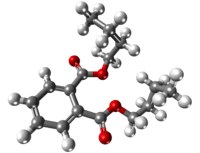Dibutyl phthalate
 | |
 | |
| Names | |
|---|---|
| Preferred IUPAC name
Dibutyl benzene-1,2-dicarboxylate | |
| Other names
Dibutyl phthalate Di-n-butyl phthalate Butyl phthalate n-Butyl phthalate 1,2-Benzenedicarboxylic acid dibutyl ester o-Benzenedicarboxylic acid dibutyl ester DBP Palatinol C Elaol Dibutyl 1,2-benzene-dicarboxylate | |
| Identifiers | |
| 84-74-2 | |
| 3D model (Jmol) | Interactive image |
| ChEBI | CHEBI:34687 |
| ChEMBL | ChEMBL272485 |
| ChemSpider | 13837319 |
| ECHA InfoCard | 100.001.416 |
| EC Number | 201-557-4 |
| 6295 | |
| KEGG | C14214 |
| PubChem | 3026 |
| RTECS number | TI0875000 |
| UNII | 2286E5R2KE |
| |
| |
| Properties | |
| C16H22O4 | |
| Molar mass | 278.35 g·mol−1 |
| Appearance | Colorless to faint yellow oily liquid |
| Odor | aromatic |
| Density | 1.05 g/cm3 at 20 °C |
| Melting point | −35 °C (−31 °F; 238 K) |
| Boiling point | 340 °C (644 °F; 613 K) |
| 13 mg/L (25 °C) | |
| log P | 4.72 |
| Vapor pressure | 0.00007 mmHg (20°C)[1] |
| Pharmacology | |
| P03BX03 (WHO) | |
| Hazards | |
| Main hazards | N), Harmful (Xi) |
| R-phrases | R50 R61 R62 |
| S-phrases | S45 S53 S61 |
| NFPA 704 | |
| Flash point | 157 °C (315 °F; 430 K) (closed cup) |
| 402 °C (756 °F; 675 K) | |
| Explosive limits | 0.5 - 3.5% |
| Lethal dose or concentration (LD, LC): | |
| LD50 (median dose) |
5289 mg/kg (oral, mouse) 8000 mg/kg (oral, rat) 10,000 mg/kg (oral, guinea pig)[2] |
| LC50 (median concentration) |
4250 mg/m3 (rat) 25000 mg/m3 (mouse, 2 hr)[2] |
| US health exposure limits (NIOSH): | |
| PEL (Permissible) |
TWA 5 mg/m3[1] |
| REL (Recommended) |
TWA 5 mg/m3[1] |
| IDLH (Immediate danger) |
4000 mg/m3[1] |
| Except where otherwise noted, data are given for materials in their standard state (at 25 °C [77 °F], 100 kPa). | |
| | |
| Infobox references | |
Dibutyl phthalate (DBP) is a commonly used plasticizer. It is also used as an additive to adhesives or printing inks. It is soluble in various organic solvents, e.g. in alcohol, ether and benzene. DBP is also used as an ectoparasiticide. DBP is also a putative endocrine disruptor[3]
Legislative control
European Union
The use of this substance in cosmetics, including nail polishes, is banned in the European Union under Directive 76/768/EEC 1976.[4]
The use of DBP has been restricted in the European Union for use in children's toys since 1999.[5]
United States
DBP was added to the California Proposition 65 (1986) list of suspected teratogens in November 2006. It is a suspected endocrine disruptor.[3] It was used in some nail polishes; all major producers began eliminating this chemical from nail polishes in the Fall of 2006.
DBP was permanently banned in children's toys, in concentrations of 1000 ppm or greater, under section 108 of the Consumer Product Safety Improvement Act of 2008 (CPSIA).
Production
DBP is produced by the reaction of n-butanol with phthalic anhydride. It is or was produced in the United States by Eastman Chemical Company, but the company announced in March 2011 that it would end production and exit the DBP and DEP (diethyl phthalate) market in December 2011.[6]
Exposure
Based on urine samples from people of different ages, the European Commission Scientific Committee on Health and Environmental Risks (SCHER) concluded that total exposures to individual phthalates in the general population are below tolerable daily intakes (TDI), except in the case of DBP for which efforts to further reduce exposures are needed.[7]
Biodegradation
The white rot fungus Polyporus brumalis degrades DBP.[8]
See also
References
- 1 2 3 4 "NIOSH Pocket Guide to Chemical Hazards #0187". National Institute for Occupational Safety and Health (NIOSH).
- 1 2 "Dibutyl Phthalate". Immediately Dangerous to Life and Health. National Institute for Occupational Safety and Health (NIOSH).
- 1 2 Williams MJ, Wiemerslage L, Gohel P, Kheder S, Kothegala LV, Schiöth HB (2016). "Dibutyl Phthalate Exposure Disrupts Evolutionarily Conserved Insulin and Glucagon-Like Signaling in Drosophila Males.". Endocrinology. doi:10.1210/en.2015-2006. PMID 27100621.
- ↑ EU Council Directive 76/768/EEC of 27 July 1976 on the approximation of the laws of the Member States relating to cosmetic products
- ↑ Ban of phthalates in childcare articles and toys, press release IP/99/829, 10 November 1999
- ↑ "Eastman Announces Discontinuation of Manufacture of DEP and DBP Plasticizers". Eastman. 16 March 2011.
- ↑ "Phthalates in school supplies". GreenFacts Website. Retrieved 2009-06-10.
- ↑ Ishtiaq Ali, Muhammad (2011). Microbial degradation of polyvinyl chloride plastics (PDF) (Ph.D.). Quaid-i-Azam University. p. 48.
External links
- International Chemical Safety Card 0036
- Dibutyl Phthalate and Cosmetics
- Hazardous substance fact sheet
- Occupational safety and health guideline for dibutyl phthalate
- CDC - NIOSH Pocket Guide to Chemical Hazards
